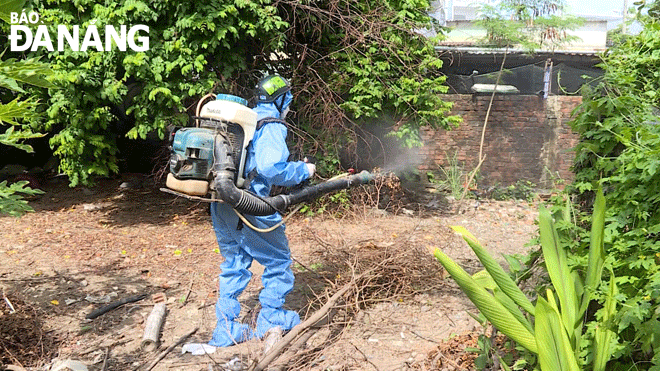Da Nang takes vigorous action to tackle dengue fever
The increasing incidence of dengue in Da Nang has been alarming as this year’s figure is higher than that of 2021 in the same period. The health sector and authorities at local level are taking vigorous action to tackle the desease with a focus on highlighting the imporatant role of local-level authorities and every one in the city in countering dengue virus infection.
 |
| A medical worker spraying chemicals to kill adult mosquitoes in order to combat dengue infections in Hoa Vang District. Photo: NGOC QUOC |
Hoa Son Commune is among the localities that have recorded highest number of dengue cases in Hoa Vang District.
Mr Ngo Minh Nhan, the Vice Chairman of the Hoa Son Commune People's Committee, said that 110 dengue cases from 13 hotspots have been reported in the commune since the beginning of the year. The localities reporting most cases are villages of An Ngai Dong, An Ngai Tay 1, An Ngai Tay 2, and Phu Thuong.
He said that the focus has been paid on promoting the health education and raising the awareness among local people in a bid to improve the control of dengue mosquito vector.
Hoa Vang District has recorded a total of 528 dengue cases since the beginning of 2022, 22 times times higher than the same period last year.
Lien Chieu District has the highest dengue incidence rate in Da Nang with 1,019 cases recorded so far this year, the figure is 40 times higher than previous years. Wards with highest number of dengue cases are Hoa Khanh Bac, Hoa Khanh Nam and Hoa Minh.
In the last 2 weeks, there has been an increasing trend in the number of dengue cases in Hoa Hiep Nam and Hoa Hiep Bac wards. A combined total of 121 hotspots or high-risk areas of dengue have been identified in Lien Chieu District so far this year.
According to the Da Nang Center for Disease Control and Prevention (CDC), the city has recorded a total of 3,305 dengue cases so far this year, 23.4 times higher than the same period in 2021 while only 132 cases were reported for the same period last year.
In particular, 262 cases were logged across the city in just one week from July 4-10. During the week, a total of 46 hotspots or high-risk areas of dengue were identified across the city: 12 in Lien Chieu District, 11 in Hoa Vang District, 9 in Cam Le District, 8 in Ngu Hanh Son District, 3 in Son Tra District, and 3 in Thanh Khe District.
Currently, Lien Chieu and Hoa Vang districts have the highest incidence of dengue cases among its population per 100,000 people in Da Nang. In 2022, Lien Chieu, Cam Le, Ngu Hanh Son, Thanh Khe and Hoa Vang districts have a higher number of dengue cases per 100,000 people than the 5-year average figure in the 2016 – 2020 period.
Doctor Truong Van Trinh, the Deputy Director of the municipal Department of Health said that prevention is still the best way to fight dengue. He stressed the need for surveillance activities that include vector surveillance and monitoring of environmental and social risk factors for dengue outbreaks to ensure that increased dengue transmission is detected early and that the response is rapid and appropriate.
The focus should be on taking necessary measures to ensure effectiveness in the city’s control and management programs of dengue mosquito vector. Heed should be paid to increase the public awareness and promote the public health along with larval and adult control campaigns.
He encouraged local residents to stay alert on the dangers of dengue fever, as well as take action to protect themselves against dengue fever at home by destroying the possible mosquito breeding sites such as water tanks, utensils, irrigation ditches and drainages as well as disposable tires and wastes.
Doctor Trinh also urged authorities at local level to give high priority to identifying high-risk areas of dengue in order to enable appropriate measures to be taken to control the dengue disease and reduce dengue infections.
Reporting by PHAN CHUNG – NGOC QUOC – Translating by H.L